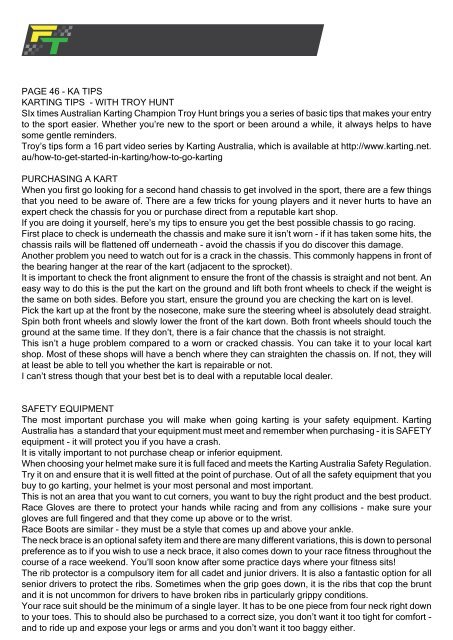Full Throttle
Create successful ePaper yourself
Turn your PDF publications into a flip-book with our unique Google optimized e-Paper software.
PAGE 46 - KA TIPS<br />
KARTING TIPS - WITH TROY HUNT<br />
SIx times Australian Karting Champion Troy Hunt brings you a series of basic tips that makes your entry<br />
to the sport easier. Whether you’re new to the sport or been around a while, it always helps to have<br />
some gentle reminders.<br />
Troy’s tips form a 16 part video series by Karting Australia, which is available at http://www.karting.net.<br />
au/how-to-get-started-in-karting/how-to-go-karting<br />
PURCHASING A KART<br />
When you first go looking for a second hand chassis to get involved in the sport, there are a few things<br />
that you need to be aware of. There are a few tricks for young players and it never hurts to have an<br />
expert check the chassis for you or purchase direct from a reputable kart shop.<br />
If you are doing it yourself, here’s my tips to ensure you get the best possible chassis to go racing.<br />
First place to check is underneath the chassis and make sure it isn’t worn - if it has taken some hits, the<br />
chassis rails will be flattened off underneath - avoid the chassis if you do discover this damage.<br />
Another problem you need to watch out for is a crack in the chassis. This commonly happens in front of<br />
the bearing hanger at the rear of the kart (adjacent to the sprocket).<br />
It is important to check the front alignment to ensure the front of the chassis is straight and not bent. An<br />
easy way to do this is the put the kart on the ground and lift both front wheels to check if the weight is<br />
the same on both sides. Before you start, ensure the ground you are checking the kart on is level.<br />
Pick the kart up at the front by the nosecone, make sure the steering wheel is absolutely dead straight.<br />
Spin both front wheels and slowly lower the front of the kart down. Both front wheels should touch the<br />
ground at the same time. If they don’t, there is a fair chance that the chassis is not straight.<br />
This isn’t a huge problem compared to a worn or cracked chassis. You can take it to your local kart<br />
shop. Most of these shops will have a bench where they can straighten the chassis on. If not, they will<br />
at least be able to tell you whether the kart is repairable or not.<br />
I can’t stress though that your best bet is to deal with a reputable local dealer.<br />
SAFETY EQUIPMENT<br />
The most important purchase you will make when going karting is your safety equipment. Karting<br />
Australia has a standard that your equipment must meet and remember when purchasing - it is SAFETY<br />
equipment - it will protect you if you have a crash.<br />
It is vitally important to not purchase cheap or inferior equipment.<br />
When choosing your helmet make sure it is full faced and meets the Karting Australia Safety Regulation.<br />
Try it on and ensure that it is well fitted at the point of purchase. Out of all the safety equipment that you<br />
buy to go karting, your helmet is your most personal and most important.<br />
This is not an area that you want to cut corners, you want to buy the right product and the best product.<br />
Race Gloves are there to protect your hands while racing and from any collisions - make sure your<br />
gloves are full fingered and that they come up above or to the wrist.<br />
Race Boots are similar - they must be a style that comes up and above your ankle.<br />
The neck brace is an optional safety item and there are many different variations, this is down to personal<br />
preference as to if you wish to use a neck brace, it also comes down to your race fitness throughout the<br />
course of a race weekend. You’ll soon know after some practice days where your fitness sits!<br />
The rib protector is a compulsory item for all cadet and junior drivers. It is also a fantastic option for all<br />
senior drivers to protect the ribs. Sometimes when the grip goes down, it is the ribs that cop the brunt<br />
and it is not uncommon for drivers to have broken ribs in particularly grippy conditions.<br />
Your race suit should be the minimum of a single layer. It has to be one piece from four neck right down<br />
to your toes. This to should also be purchased to a correct size, you don’t want it too tight for comfort -<br />
and to ride up and expose your legs or arms and you don’t want it too baggy either.


